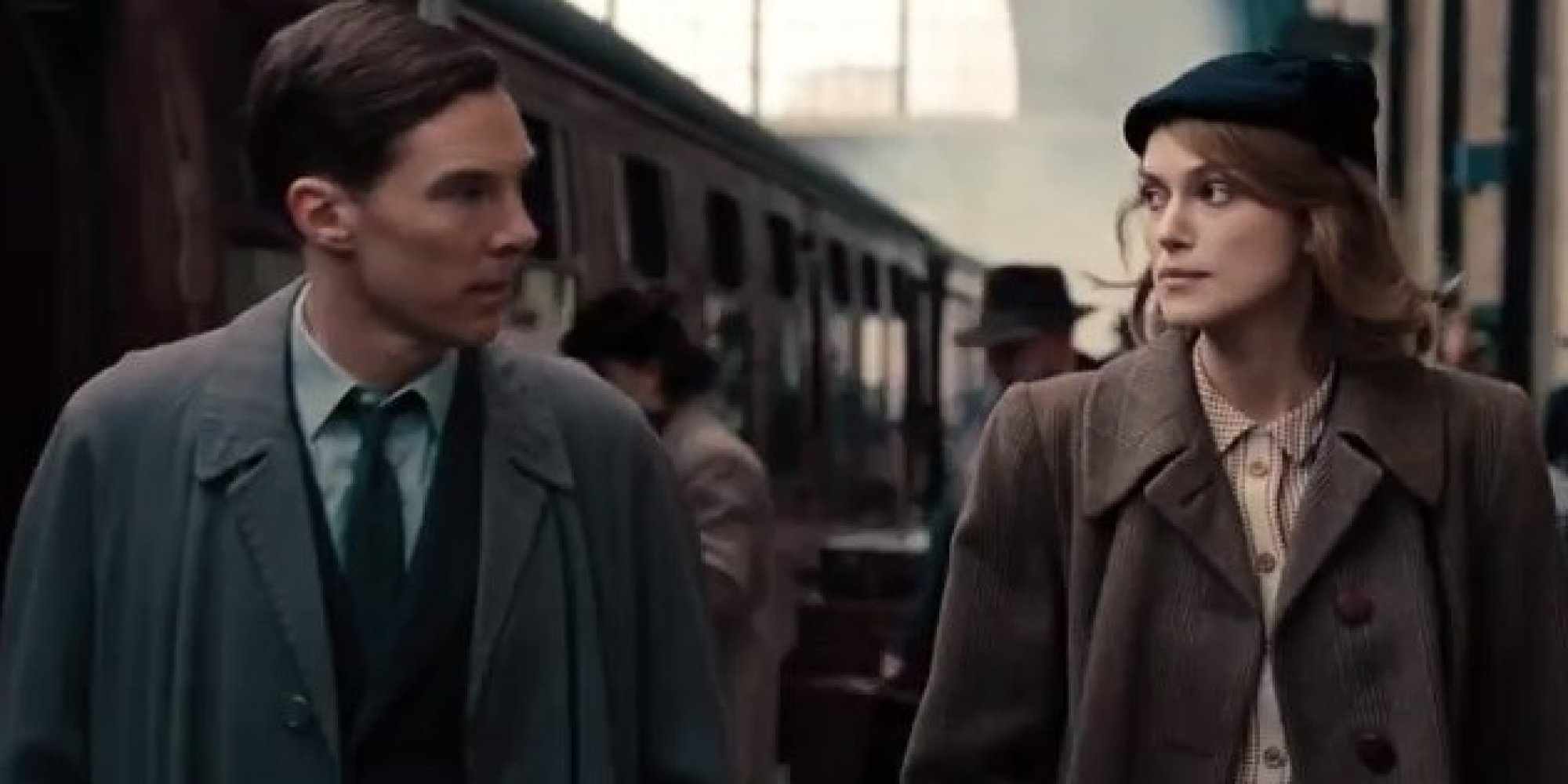A stereotype in popular media about very smart people is that they must have some great deficiency in other areas of their lives–as if someone with extraordinary intelligence being able to make friends and get laid would be unfair to the rest of us. The only reason I can surmise for the positive reviews The Imitation Game, a highly fictionalized new film about gay, World War II codebreaker Alan Turing is that it confirms all the “normal” audience’s worst suspicions about “genius” and queer life, without offering any meaningful insight into either.
Sometimes I wish the mainstream film industry would stop making movies about queers. The rare times that a queer person is allowed to be the main character in one of its movies, as in this one, he (almost always a “he”), like the rare main character of color is usually unrealistically isolated from the community he comes from, a trope fostered from before Stonewall to the ’90s to now: we are oh-so-tragic and oh-so-alone. Because he has no peers to rely on, the main gay guy invariably confides in the straight guy (particularly ridiculous in The Imitation Game’s 1940s setting) just like in movies set in the Civil Rights-era South, Black people have all their deepest conversations–and bonds–with white people. When a film shows the rare group of people of color relying on each other, as in Selma, awards snub it and prominent white guys denounce it. When a film like the underrated Pride shows a group of queers working together, the blurb on the back of the DVD makes sure it doesn’t offend any “Christian values” by mentioning something as crass as LGBT identity.
“Homosexuals”–as they were known then–could be arrested during the time the film takes place (as Turing was after the war, one of the few parts of the film that isn’t doctored) and imprisoned both in England and elsewhere, but that didn’t stop them from existing or having sex with each other–and straight people knew them even if they didn’t acknowledge that they did. World War II was a vehicle for many queers from the US (and probably those in the UK too) to find each other, no longer isolated in their small hometowns. But even before the war, academia (where Turing came from) was, notoriously, also a refuge for gay men. The arts were another. Accounts from those who knew him say that Turing was quite open about his sexuality (instead of the anguished confessions we see here): and then, as now, straight people (and I’m presuming most of the people interviewed were straight) were always the last to know. Also unchanged in the intervening years: the rules for men in power or ones with powerful friends were different: actor John Gielgud was arrested in the same time period as Turing was for having sex with another man, but faced neither imprisonment nor the forced hormone treatment Turing accepted instead of a prison sentence.

All the most interesting twists of the story are the ones the film avoids. As part of the huge wartime operation at Bletchley Park Turing had helped win the war against the Nazis (in fact his team’s decryption might have been the deciding factor) but he couldn’t tell anyone about it–nor could anyone else. Some powerful people did write letters of support for him during his trial, but they couldn’t say precisely why they were writing them. If his work during the war hadn’t been secret the charges against him probably would never have come to trial–or been made in the first place.
Instead, what passes for drama in this film are pedestrian scenes that are the invention of screenwriter Graham Moore. Even though there’s no historical evidence of any such incident we get more than one sequence in which Turing’s supervisors attempt to destroy his work. “You will never understand the importance of what I’m creating here,” Benedict Cumberbatch, as Turing, cries in the first film performance I’ve seen that is best encapsulated by the phrase “the gnashing of teeth.”
These scenes might be a reflection of the vanity of its hack filmmakers (writer Moore along with director Morten Tyldum). “I’m afraid these men would only slow me down,” the film’s Turing says about the team of other codebreakers. Not only does this film leave out all the other people (including some Polish cryptologists who made a valuable prototype) who helped Turing get to the point where he could successfully design and run Bombe (not “Christopher”: the name Turing gives his codebreaking computer in the film– after his first love!) but in the film he’s also perpetually misunderstood and under-appreciated by others the same way white, male writer and director “auteurs” seem to often feel they and their own work are, even as they dismiss (and underpay) the many other people who make their films possible and enjoyable. Maybe this parallel is the reason for the spate of “great man” films and the awards they always seem to collect this time of year.
The lone woman with a decent-sized part in the film is Joan Clarke (played by Keira Knightley) Turing’s fellow cryptanalyst who becomes his friend and, for a time, is engaged to him. Unlike the ridiculous scene in the film when Turing breaks up with her, the real-life Clarke was reportedly “unfazed” when she found out her fiancé was queer, because in those days (as the film touches very briefly on) marriage was the only way for most young women to get away from the control of their parents.
And even though a big deal is made of Joan Clarke being one of the only woman cryptanalysts, like “Rosie The Riveter” stateside, 80 percent of Bletchley Park’s employees were women. The codebreakers were popularly known as “Dilly’s girls” after the (male) head of the operation, none of which is reflected in Game. Thanks for erasing the historical contributions of women again, mainstream film industry!
[youtube_sc url=”https://www.youtube.com/watch?v=S5CjKEFb-sM” iv_load_policy=”3″]
Another film about genius and secrets making the rounds of top ten lists and awards is Laura Poitras’s Citizenfour, the documentary about Edward Snowden, who acted as a whistleblower by releasing evidence of the US’s widespread and unconstitutional spying on its own citizens.
You’d never know from the many news accounts about Snowden that Poitras was the first person he made real contact with when he decided to go public. Poitras reads his first message aloud on the soundtrack, “Laura, at this stage I can offer nothing more than my word. I am a senior government employee in the intelligence community. I hope that you understand that contacting you is extremely high-risk.”
The film makes clear, hilariously, that when Snowden first tried to get in touch with Glenn Greenwald, who is usually given the credit for bringing Snowden’s story to the rest of the world, Greenwald couldn’t learn to use the encryption Snowden (who knew how volatile this information was) insisted on, so Snowden moved on to Poitras (who was well-versed in encryption after the government had seized footage from her previous documentaries, including one about the Iraq war). After a time Snowden suggesting that she bring in Greenwald–when presumably she could instruct him what he needed to do to get his encryption skills up to snuff.
Citizenfour, I had to keep reminding myself, shows us history in the making. We meet Snowden before his first media interview. We see him in the hotel room in Hong Kong where he was first holed up when the story broke. I had to keep telling myself what I was seeing was important because most of it is otherwise pretty dull.

We never find out much about Snowden beyond what we’ve seen in other media. He is a man who is preternaturally sure and calm about what he’s done, perhaps because, as an autodidact (he has a GED) at the top of a highly skilled field, he was able to think for himself on the implications of the work he was being asked to do.
We do see the travails of another whistleblower who went through more traditional channels and is still suffering blowback for it, to show us why Snowden released the info to the media directly. And we see Snowden upset at how the girlfriend he lived with and left behind in Hawaii is treated by the government in his absence. But as a friend remarked as we left the theater, “Watching Edward Snowden stare at his laptop isn’t very exciting.”
Although Snowden was sure he would be tried and imprisoned for his actions, saying in one of his preliminary messages to Poitras, “In the end if you publish the source material I will likely be immediately implicated,” he eventually saw that he could, with help, escape and chose to do so. But the scenes that should build up tension and our empathy for him (even those of us who admire his actions and sympathize with his plight) fall flat.
An exception is when we see Snowden’s face on video blown up to epic proportions in a main Hong Kong Square, just after his first big media interview, and then cut back to Snowden still in his hotel room, trying to change his appearance so he won’t be recognized (and abducted) on his way to the airport. Otherwise we don’t feel like we are in Snowden’s shoes in this film, even as we spend much of our time looking and listening to him. At the end we see Snowden has reunited with his girlfriend in Russia (where he has been trapped since the US government cancelled his passport–just before he could catch the second leg of his escape flight). We see them through a window, preparing dinner together, from a distance, an apt metaphor for how well we have come to know Snowden in this film ostensibly about him.
[youtube_sc url=”https://www.youtube.com/watch?v=XiGwAvd5mvM” iv_load_policy=”3″]
________________________________________
Ren Jender is a queer writer-performer/producer putting a film together. Her writing, besides appearing every week on Bitch Flicks, has also been published in The Toast, RH Reality Check, xoJane and the Feminist Wire. You can follow her on Twitter @renjender






